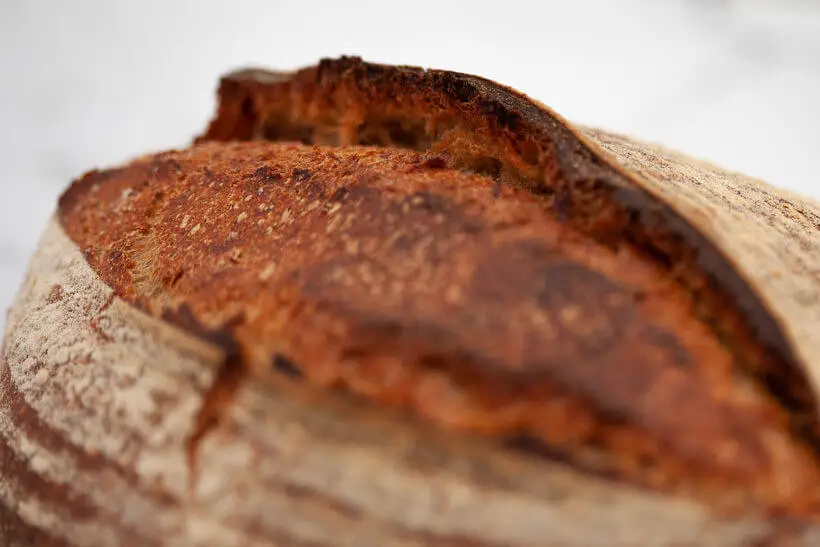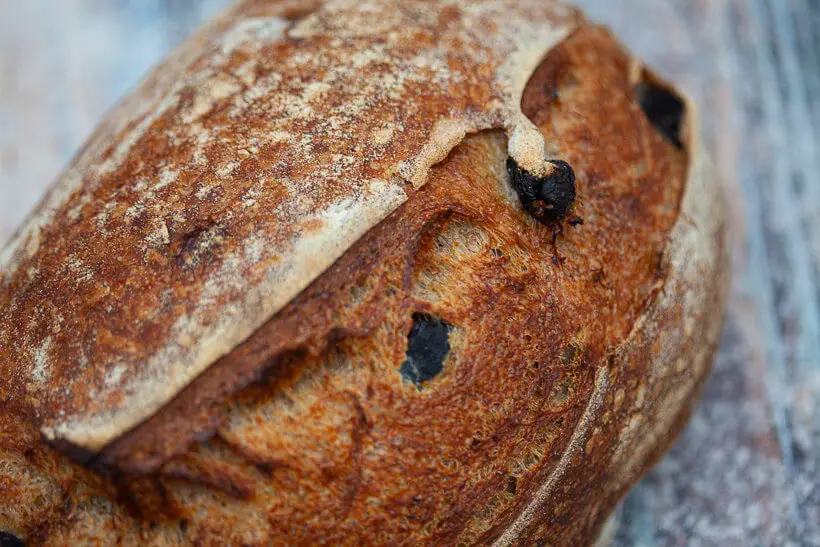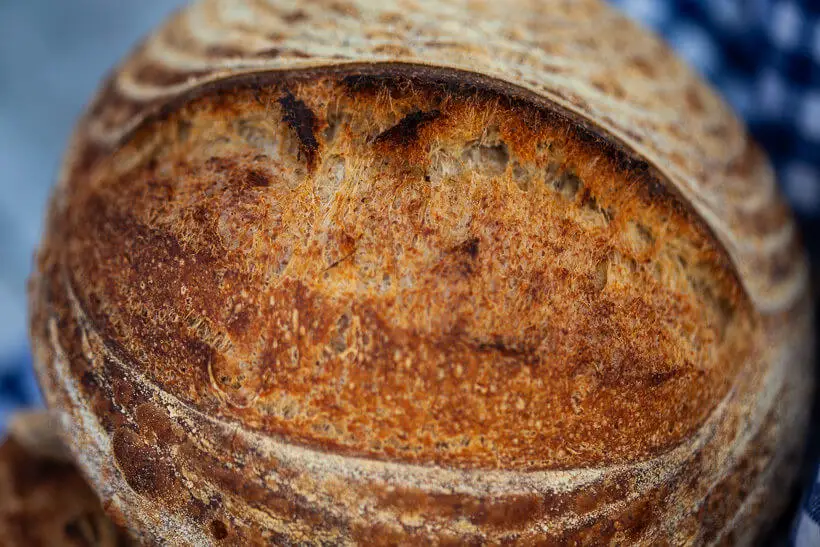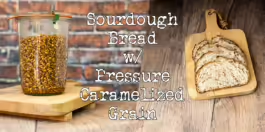[print-me title=”Print”]
Or how I learned how to bake artisan sourdough bread. Sourdough bread is the new black. Everybody wants to eat it and more than that, bake it. Getting started can be difficult: making the starter, different techniques that go into making and baking the bread, and in the end, all you get is a flat piece of bread. What gives? These are my secrets to getting great oven spring in your sourdough bread.
I started baking sourdough bread a while back. I knew nothing about it, but I had a month at home recovering after surgery. The first struggle was to make the starter. It was winter, so my kitchen was rather cold and I didn’t know what effect it would have on making a starter.

When I found out, I ended up buying a Brød & Taylor proofer. My kitchen was on the chilly side and for the longest time, I didn’t realize that yeast thrives when it’s close to 30°C/85°F.
That’s where I started my journey into the magical world of sourdough. It included some flat and dense pancake-like bread with no oven spring whatsoever. Making notes about everything in every bake, I started to get a grasp of how everything works within the dough, and how everything affects the oven spring in sourdough bread.
Today they call me the dough whisperer. Actually, I don’t think anybody calls me that, but it would be cool if they did.
Now I am going to spill the beans.
If you feel it’s a bit of a long article to read, I’ve made a video where I explain it all:
How the strength of your starter contribute to oven spring in your sourdough bread
The foundation of rising your sourdough bread is your sourdough starter. Before you start baking with your starter you need to make sure the starter is strong and has the maximum amount of yeast and lactobacilli possible.
This is not something that you have to repeat over and over but should be done as part of building the initial starter.
If you still don’t have a starter, you can read my guide for making a sourdough starter. It’s easier than you think.
So what does a super active starter look like?
My starter is super active. This means that it grows to over triple the size in about 7 hours at room temperature. This is what you want to get for that coveted open spring.
In this video, you can see my starter after a feeding. I’ve fed it 1:2:2. If you are not familiar with this notation it explains the proportions of starter to flour to water in that order.
So if you feed 1:2:2, you could take 10g of starter, 20g of flour, and 20g of water, or it could be 200g of starter, 400g of flour, and 400g of water.
You really shouldn’t be making more sourdough starter than you need, so make the amount you need for your next bread, plus 25g to keep the starter going.
So I already have a starter that is established, but it’s kind of sluggish. What do I do?
Well, there are a couple of things that are important to maximize your sourdough starter’s potential:
- Heat
- Flour selection
- Water
- Feeding schedule
- Feeding proportions
Let’s look at each component separately.
What does heat do?
Your starter will contain wild yeast. Exactly what strains will depend on where you live, the biochemistry of your hands, and probably a bunch of other factors. To the final bread, it really does not matter where the yeast came from, just the density in the starter.
Yeast is somewhat of a hedonist. It loves to hang out in a warm environment and multiply. The best temperature for it to do this is between 27°C/ 80°F and 32°C/ 90°F. This means when you are developing your starter to be strong, you must store it somewhere warm to give it the best growth opportunity.
So spend a bit of time and find that warm spot in your kitchen. It should be a stable temperature, so big fluctuations are not good.
It could be:
- your window sill in the sun
- on top of your refrigerator
- in the oven, with the oven light turned on
- in your proofer
Why does it matter what flour I use?
When you feed your starter the flour that you choose can impact the strength wildly.
You want to completely avoid any cake flours or bleached all-purpose flours. They simply don’t have the nutrients needed to make a sourdough starter.
I’d recommend using whole grain. Maybe not as all of the flour, but maybe half. Rye is great, but regular whole grain wheat flour is good too. If you own a flour mill, freshly milled flour is yeast’s favorite food.
Can I just use tap water?
Your tap water can inhibit your starter. I live in Denmark and we have crazy good water quality. The stuff that comes straight out of the tap is wonderful. Why people buy bottled water here, makes no sense to me.
Where you live that might not be the case. Ask yourself this: “Do I want to drink the water straight out of the tap?”, if the answer is a resounding “No!” then maybe you should probably not feed it to your starter.
If the only thing that’s problematic about your water is chlorine, then put some water in a bowl and leave the water on your kitchen counter for a couple of hours. The chlorine will dissipate and it’s ready to use for your starter (and bread).
What kind of feeding schedule should I use then?
When you are trying to maximize the yeast in your starter, the best thing you can do is to feed it right as it starts to deflate, because that’s when the yeast has “eaten” all the sugars in the flour and will be starting to get hungry.
That is going to be hard to keep up with, so if you space out three feedings with 8 hours in between. That should work just fine. So if you’re an early riser, feed it at 6:00/6 a.m., 14:00/2 p.m., and 22:00/10 p.m. If you like to sleep in you can do 9:00/9 a.m., 17:00/5 p.m., and 1 a.m. Whatever fits your schedule.
If that seems like too much, just feed as you get up, somewhere in the middle of your day, and right before you go to bed. There’s no need for sourdough to control your life. At least that’s what I keep telling myself.
How should I feed my starter?
The proportions of starter to flour to water are important. The more flour and water you have compared to the starter, the more food is available to the yeast. The abundance of food in presence of yeast the more it will multiply. So for this part, I recommend using 1:5:5 for everyday feeding, but to make it crazy active you can try for 1:50:50.
That means you add to a container:
- 5 grams of starter
- 25 grams of whole grain wheat flour (or a half and half mixture of whole-grain wheat flour and bread flour)
- 25 grams of room temperature water
You don’t need any more than that. There’s no reason to waste flour.
How do I store my sourdough starter?
When the sourdough starter is good and active, you need to store it somehow.
You can store your sourdough starter in many ways, but the best way for a very active starter is to keep it on the kitchen counter. I store mine on the counter all year round, and I don’t feed it every day. I usually feed it once before I need it. Sometimes I don’t feed it for weeks and it’s just fine.
The important thing is to be pretty vigilant about hygiene. Use clean utensils, and switch to a clean container every time you feed. That way you minimize the possibility of mold and fungus, which are the biggest contributor to starter death.
If you are afraid of losing your starter, keep a backup in your fridge. You don’t even have to feed it. It can be revived in a manner of hours, maybe days if it’s super sluggish. Just follow the tips in the previous section.

The role of gluten development in oven spring in sourdough bread
Getting the gluten properly developed in your bread is essential to pretty much everything in your bread. Oven spring, texture, crumb, crust.
It’s something that’s often overlooked when people bake with commercial yeast because the yeast is so potent that the bread will rise even if you don’t have much gluten development. Plus paired with the fact that yeasted bread is often of much lower hydration than sourdough bread, makes it seem like the bread stays together.
So how do I develop gluten?
Gluten is developed in dough by the proteins in the flour being hydrated. Agitation (like kneading, slap and fold, stretch and fold or coil fold) will accelerate the process. If you want to know about the specifics, Modernist Cuisine has published an article about gluten development. It’s pretty technical. Don’t say I didn’t warn you.
Autolyse? What is that?
A good way to get a head start is to use autolyse (meaning self-mixing). Autolyse consists of mixing the flours and fluids for the bread formula and letting them stand around to just get to know each other. The presence of water in the flour will hydrate the proteins glutenin and gliadin which then starts a chemical process that creates gluten.
Most sources I’ve seen recommend an autolyse time of twenty minutes to sixty minutes, but often I will autolyse for four hours with no ill effects. Your mileage may vary.
It’s important to note that you should not mix in any starter or salt at this point. It’s only flour and water.
If you add sourdough starter the dough will start fermenting, which is not what we want at this point. We only want to develop gluten.
If you add salt at this point, it will tighten up the gluten structure, which will make mixing the dough difficult, so we wait with the salt until just before we start the bulk fermentation.
Can I check if the gluten is properly developed?
It’s a good idea to test if the gluten is developed properly after your last stretch and fold. If it the gluten isn’t properly developed, I’d recommend extending the bulk and doing more stretches and folds.
The way you check the gluten development is by “pulling a windowpane”. That means that you grab a piece of the dough and stretch it between your fingers. Working slowly and extend the dough until it is so thin, that you can see light through it.
If the dough breaks during this process, that means the gluten hasn’t been developed properly.
You can see me “pull a windowpane” here:
How does bulk fermentation affect oven spring in sourdough bread?
Bulk fermentation is the time when we agitate the dough to strengthen it and let the wild yeast do its work.
Usually, bulk fermentation is split into two parts. The first part is where we stretch and fold the dough and strength is being built. Gentle handling here is key to getting that coveted open structure.
Just leave it alone!
The second part is the rise, where the dough is left alone while it ferments. Usually, you let the dough rise from 20% all the way up to 100%.
The term “under fermented” means the dough hasn’t expanded enough to be ready to bake.
The term “over fermented” means that the yeast in your starter ate all the food and there is none left for it to eat and produce CO2 which is what gives the rise and the holes in the crumb.
If you have an active starter that expands to triple the size when it’s fed, you can absolutely let the dough rise to double the size. There’s still enough food in the dough for the yeast to make the bread rise during baking.
To get a good oven spring I usually let the dough grow about 50%, so there’s still a lot of rising left. This dough is probably slightly under fermented. I guess it’s a hack. I should make a YouTube video: “One crazy hack that will make your sourdough bread blow up!”.
How do I know when the bulk fermentation is over?
Judging when the bulk fermentation is over is not only about the amount that it’s grown, but also about how the dough feels. The dough should feel light (not weight-wise), puffy, and have visible signs of fermentation: bubbles and bulges in the dough. Also, if you wiggle the container it’s in, the dough should jiggle and not seem rigid.
It’s a learned skill to judge fermentation, so all I can say is: bake, bake, bake. Notice how the dough looks and how the bake goes and you will start to get an idea about how it works.
Shaping is essential to oven spring in sourdough bread
Pre-shaping and shaping are very important when it comes to oven spring in sourdough bread.
After you’ve built an amazing gluten network in your bread dough, you want to position some of the gluten on the outside of the dough. It should be a tight network that holds the dough together.
There are a few reasons for this:
- It will help your loaf stand up straight and not turn into a puddle in the oven.
- It will help the dough stay together and only expand in the places where you’ve scored the dough.
Retard? That isn’t politically correct!
It is important to retard your dough. Retard means to let the dough rest in the fridge after it’s been shaped and put into the banneton.
Here’s why that is important:
- the cold dough doesn’t collapse so easily, and it’s much easier to score. So while you are handling it won’t just turn into a puddle on your table.
- cold dough will release more steam and for longer than a room temperature bread, which means… more oven spring.
Why scoring the bread is important for oven spring in sourdough bread
Scoring the bread is important because it lets you decide where and how much your bread should open up. You can leave it to chance, but if you actually built enough gluten in the dough and fermentation went on a bit longer or your starter isn’t super active, you may get a dense bread.
Reasons to score your bread:
- It will help you decide where the bread will open up during baking. People tend to love “ears” on their loaves, and that’s how you get them.
- It will help you get a more open crumb. When the bread opens up it can expand upwards leaving room for the crumb to open up.
- It looks really awesome (no, it’s not related to oven spring)

The importance of baking with heat and steam for great oven spring in sourdough bread
To maximize the possibility of oven spring in your sourdough bread you need to bake as hot as Hell. It’s not a swear, it’s an actual temperature. You will also need to bake with steam.
Why so warm? Does it really make a difference?
The reason you need a lot of heat at the beginning of the baking, is you need most of the loaf to be heated through as quickly as possible. Most of the rising in the oven happens within the first ten to fifteen minutes of baking.
For that reason, you also need everything in your oven to be completely saturated with heat. I normally start out at 260°C/500°F and let the oven and the combo cooker be heated for an entire hour.
I also have a baking steel in my oven. It helps retain heat when I open the oven door and it makes the heat more even in all spots of the oven.
Home ovens work by having heating coils at the top and the bottom of the oven. That means that you might get a burned bottom or a scorched top. The steel or a pizza stone will really help mitigate this problem.
Steam? What does that do?
The reason you need to bake with steam is actually to maximize the oven spring. The moist environment that you create in your oven makes it so that the crust takes longer to set. That means the parts of the crust where you scored your loaf can extend for a longer period of time. That means the interior gets larger, meaning a more open crumb and more oven spring.
I bake using a combo cooker most of the time. It just simplifies baking and gives a great result every time. You can absolutely steam by using your oven’s steam function (if you have one of those) or adding a pan with boiling water as you start baking.
The summary: How to get great oven spring in your sourdough bread
This is a checklist for you to get amazing oven spring in your sourdough bread every time:
- Make sure your starter is healthy and super active.
- Make sure you develop gluten.
- Use autolyse.
- Pull a windowpane to test it.
- Learn how to time bulk fermentation.
- Make sure you ferment your dough until it feels light, puffy, and bubbly.
- Under ferment a bit to maximize oven spring.
- Shape the dough so you get a really taut surface. Remember this requires proper gluten development, see 2)
- Retard your dough.
- Score the dough in a pattern that will let the bread expand.
- Bake hot and with steam.
If your bread fails, go through your notes (you do take notes when you bake, right?). Figure out at what step you failed and learn something for your next bake.
If you need an actual recipe for sourdough bread, I have this great sourdough bread for beginners recipe that is a great place to start.
That’s it! You know all my secrets about oven spring.
Please share on social media to let others get amazing oven spring in their sourdough bread
These are the secrets to getting a consistent great oven spring in your sourdough bread. I hope that you learned something new and that you will get sourdough bread with an amazing oven spring every time from now on. If you found it useful please consider sharing it with fellow bakers on social media. That would make me very happy.











Is the starter feeding ratio 1:5:5 above an error? If not, when does 1:2:2 apply and when does 1:5:5 apply? Thanks for this excellent article.
Well, once you want to optimize your starter, feeding 1:5:5 is more effective. When it triples in a feeding you have enough yeast in your starter, then you should use feeding proportions to time when to use your starter.
If you want to bake a quickly as possible, feed it 1:1:1, if you want to let the starter grow overnight you’d feed it to stretch the growing out over the whole night.
Watch my timelapse here what difference it makes: https://fdgk.net/feeding-proportion-timelapse 🙂
Hi. I enjoy this blog and appreciate your guidance and expertise. Thanks for the advice about putting a baking stone on the bottom rack of the oven. I’m new to baking bread and use a Dutch oven. I’ve been struggling to get the loaves nice and dark, which I prefer, without burning the bottom crust. I’ve moved the DO to the next rack up after the first 20 minutes, and that helps, but it’s a real pain to do mid-bake.
I just baked a loaf of white, whole wheat, and dark rye sourdough, and it turned out beautifully. I got great oven spring, a gorgeous crackling crust on the top and sides, and no scorched bottom crust. Now I just need to be patient and wait another hour before I can cut into it.
I’m glad that it’s working for you. Domestic ovens are pretty fickle in how it heats, and figuring out where to bake in your particular oven can be a bit of a struggle 🙂
Amazing instruction! Thank you sooo much!
Thank you <3
Hi Sune, I have a question about building my starter, which you talked about in this article.
You mentioned 1:5:5 at 5g:25g:25g as a way to build up strength, and also a 3-feed schedule (6:00/6 a.m., 14:00/2 p.m. and 22:00/10 p.m.)
At 6am you do the 5g:25g:25g, then once it’s peaked do you take out 5g and do another 5g:25g:25g at 2pm and the same at 10pm?
The next day when you want to make bread, do you do a 1:5:5 on what you need for baking, so if I need 100g for baking, I would mix at 6am a 9g:45g:45g?
You may wanna make a bit more so you don’t bake off your starter in the bread.
Do a 12g:60g:60g so you have a little bit of starter to keep the starter going 🙂
Your channel is so useful! I only have a air fryer but I can bake some bread rolls now. you make bibimbap better than my mom. keep going man!
Thank you <3
Hi,
Thnx for the tips, most of them i am already aplying. One thing that really triggered me was the scoring and baking the cold dough, as i read somewhere else that you should not because the crumb will not set. Neverheless i have usually a reasonable bread but it will not spring as much as i want. Do you mean with cold straight from the oven or like half an hour/hour out of the fridge in comparison with the 2,5, 3 hours most recipies recommend?
I take it out of the oven, score it and put it straight into a scorching hot dutch oven.
See this video for what preheating does for oven spring: https://youtu.be/8CyYA-p1dMA
Thank you Sue for all your wonderful tips, I followed your advice today and made a beautiful super oven spring loaf. I am so happy it is such a beauty!😘😘
Do you spray the dough with water before placing the cover on and placing in the oven?
I don’t usually, but it makes these gorgeous blisters on the bread, so do it if you want that 🙂
Hey Sune, first of all thank you for all the experiments that you do. I am always excited when you upload a new youtube video. I have been baking sourdough for about a year now, but I have a problem. My first bread always turns out great and has amazing oven spring, but that’s because I only leave it in the fridge for the day and bake it the following day. I like making enough bread to last the week so I have 2 other sourdoughs. I’ve tried both the fridge and the freezer. Normally it sits 3 days in the fridge before I bake it, but when I take it out of the bowl it is more liquidy and makes it more difficult to score. It seems like it was overproofed and I get very limited oven spring from it. I’ve also tried freezing the dough and put it in the fridge an day before I bake it to warm it up, but I find that it’s even worse off and it gets a little raw inside after I bake it. What would you suggest to maintain that oven spring when storing it in the fridge/freezer?
Also I would also like to note that I use a dutch oven and I find that my breads are done after 25 mins at 500F and 5 mins at 450F with the lid off. I recall watching one of your videos saying 20 or 25 mins at 500F and another 20 to 25mins at 450F with the lid off. Why would mine be different? I followed your sourdough recipe for that one as well.
For what length of time do you retard the shaped loaves in the frig before putting them directly into the oven?
Often about 8 hours, but sometimes days, 2-3 days is fine 🙂
Which is it, 1;2;2 or 1;5;5?
When optimzing your starter for maximum yeast. After it’s established use whatever proportion that fits with when you need your starter to be ready 🙂
Thanks for the tips, they have been very helpful. I read you place dough in refrigerator for up to 36 hours. How do you keep the dough from overproofing? Also, do you bake directly from the fridge or let the dough come to room temperature first?
My fridge is very cold. 2C, around 35.5F 🙂
Thanks for this document. Here you mention not to mix in salt at autolyse step but in most of your videos you mention adding salt at the autolyse step. Has the tip about tightening the gluten changed?
Are you baking your sourdough bread on the steel in a fan/convection oven?
Is there a trick to baking sourdough bread straight onto a pizza stone in the oven? Mine work perfectly when I put them in a pyrex dish with a lid, but if I try and free form them onto a hot stone in the oven (with a tray of water at the bottom of the oven), they just don’t work out quite as well – they’re edible but don’t have that lovely rise and split at the top (and I have to almost saw through the crust).
Thank you so much for providing such a great site and am loving all your videos. I have baked a few times but am still struggling and havent achieved a loaf that I could be proud of. I have a few questions and I hope you can shed some light on them.
How can I determine if my flour is well hydrated? Since all different branded flours have different water absorption, is there a way we can determine how much water each kind of flour can absorb?
What is the minimum number of min hours needed for bulk fermentation if my average temperature here is 31 degree celcius?
When I shape my dough, it could stand and the surface seems to have enough tension (or so I thought), but when I score, the dough kind of sinks. Is that overproofing?
How do you know when to stop kneading the dough after adding the salt? Are there any indications from the dough that we should pay attention to? One time, I was kneading (probably slightly too long), and my dough became over stretchy and soft.
What temperature should the fridge be? My dough came out almost triple the size the next day and it’s wobbly. When I score it, the dough sinks.
Lastly, how do you determine the number of folds your dough need?
Thank you so much once again!
hi, when i put my loaf in a deck oven, i get cracks all over the place. Why is that happening? i even tried putting in a dutch oven but its making my loaf fall flat. I used to be able to bake beautiful loaves at home but the deck oven doesn’t seem to be working. Please help!
Ever tried a slightly smaller granite slab on bottom of Dutch oven to create a reservoir for boiling water.
No, but I’ve never had to add water to the dutch oven 🙂
Hi Sune – kan se på seneste video at du har fået en Challenger! Har du en affiliate aftale med dem? Hvis ja – så køber jeg den igen dig;)
Tak for alle de gode sourdough tips og opskrifter! Hilsen Marianne
Tak <3
Ja, det har jeg. Du kan bruge dette link: https://fdgk.net/buy-challenger-bread-pan
Hi!! I created steam in my oven, but I didn’t have a baking stone. I used a baking pan instead. I didn’t get the oven spring or ear that I usually get when using the Dutch oven. I want to make a larger bread this time. Does it make a big difference using a baking stone vs sheet pan?
This was so helpful! Thank you for sharing!
I had been baking sourdough bread for about 3 years. I thought I was happy with the outcome, until I saw your bread! I have been using your Master recipe for Artisan Sourdough bread for about 3 months now and am absolutely amazed with every loaf. They come out beautiful and light and wonderful open crumb. Thank you! I have shared the recipe with friends and family.
I am very happy to hear that 🙂